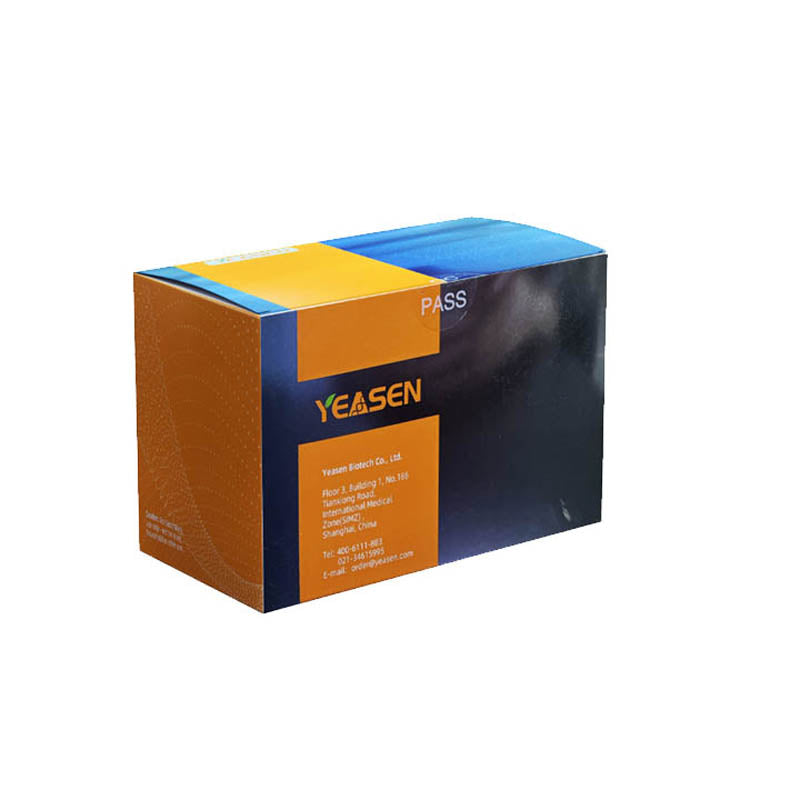Description
Vero Host Cell DNA Residue Detection Kit is used for the quantitative analysis of Vero host cell DNA residuce in intermediate samples, semi-finished and finished products of various biological products.
This kit adopts Taqman fluorescent probe and the polymerase chain reaction (PCR) method, which has fg level minimum detection limit and can specifically and quickly detect the residual Vero cell DNA. The kit needs to be used together with the Residual DNA Sample Preparation Kit (Cat# 18461ES).
Product Components
|
No. |
Name |
41307ES50 |
41307ES60 |
|
41307-A |
Vero qPCR Mix |
0.75 mL |
1.5 mL |
|
41307-B |
Vero Primer&Probe Mix |
200 μL |
400 μL |
|
41307-C |
DNA Dilution Buffer |
1.8 mL×2 |
1.8 mL×4 |
|
41307-D |
Vero DNA Control(30 ng/μL) |
25 μL |
50 μL |
|
41307-E |
IC* |
50 μL |
100 μL |
*IC:Internal control
Features
Strong anti-interference: Achieves 70–130% spike-and-recovery across complex matrices.
High sensitivity: Lower limit of quantification (LLOQ) reaches 0.5 fg/μL.
Excellent precision: Intra-assay CV < 10% and inter-assay CV < 15%.
High specificity: Designed for specific detection of Vero residual DNA with no interference from other genomic DNAs.
Built-in internal control (IC): Detects sample inhibition or reaction errors, minimizing false negatives.
Well-validated: Method validated according to ICH Q2(R2) guidelines; full validation report available.
Regulatory compliant: Verified following EP 2.6.7, JP G3, and USP <63> requirements.
Reliable quality: All enzyme components are self-manufactured and fully industrialized, ensuring stable supply.
Shipping and Storage
1. Shipped on dry ice and stored at -20°C for 2 year
2. After receiving the goods, please check and store them in the corresponding storage temperature immediately.
Cautions
1. Please read this manual carefully before using this reagent, and the experiment should be standardized, including sample handling, reaction system preparation and sample addition.
2. Adding samples and preparing solutions is best done on ice.
3. Ensure that each component is fully vortexed and centrifuged at low speed before use.
4. For your safety and health, please wear lab coats and disposable gloves for operation.
5. This product is for research use ONLY!
Applicable instrument models
Include but not limited to:
Bio-Rad: CFX96 Optic Module.
Thermo Scientific: ABI 7500; ABI Quant Studio 5; ABI Step OnePlus.
Instruction
Figures
1.Good linearity: Linear range from 3 fg/μL ~ 300 pg/μL, R²= 0.999, Eff=95.6%, CV<15%.

Figure 1. Vero DNA standard curve graph (left) and amplification curve linearity graph (right)
2. Specificity
To assess potential interference from genomic DNA commonly encountered in biopharmaceutical manufacturing, Vero DNA was tested in the presence of genomic DNA from E. coli, CHO, and HEK293 cells. The amplification curves of all interference groups completely overlapped with the Vero-only control, indicating no detectable cross-reactivity or signal interference (results shown below: Vero, Vero + E. coli, Vero + CHO, and Vero + HEK293).

Figure 2. Specificity/interference test results.
3. High Recovery
Vero DNA (300 fg/μL) was spiked into five challenging matrices—high protein, high nucleic acid, high salt, high pH, and low pH. Each sample was extracted in duplicate and tested in triplicate by qPCR.
Across all matrices, recovery remained within 70–130% with CVs below 20%, confirming reliable performance under diverse sample conditions.
Table 1. Recovery of Spiked Simulated Samples
|
Sample Type |
Theoretical Concentration (fg/μL) |
Extraction 1 (fg/μL) |
Extraction 2 (fg/μL) |
Extraction 3 (fg/μL) |
Average Measured Concentration (fg/μL) |
Recovery (%) |
CV (%) |
|
Baseline Sample |
— |
— |
— |
— |
— |
— |
— |
|
High Protein |
300 |
316.18 |
302.65 |
278.08 |
298.97 |
99.66% |
6.46% |
|
High Nucleic Acid |
300 |
265.08 |
256.60 |
316.70 |
319.70 |
106.57% |
11.64% |
|
High pH |
300 |
325.21 |
325.91 |
281.96 |
311.03 |
103.68% |
8.09% |
|
Low pH |
300 |
241.65 |
254.24 |
254.59 |
250.16 |
83.39% |
2.95% |
|
High Salt |
300 |
229.23 |
221.37 |
248.37 |
232.99 |
77.66% |
5.96% |
4. Limit of Quantification (LOQ): 0.5 fg/μL.
Vero DNA was tested at the lowest point of the standard curve (3 fg/μL) and at lower concentrations of 1 fg/μL and 0.5 fg/μL, with 10 replicates per level. At 0.5 fg/μL and above, the CV was < 20%, establishing the LOQ for residual Vero host-cell DNA as 0.5 fg/μL.
|
Replicate |
Vero DNA (fg/μL) |
Back-calculated (%) |
|
1 |
0.51 |
102% |
|
2 |
0.43 |
86% |
|
3 |
0.46 |
92% |
|
4 |
0.34 |
68% |
|
5 |
0.36 |
72% |
|
6 |
0.38 |
76% |
|
7 |
0.38 |
76% |
|
8 |
0.41 |
82% |
|
9 |
0.36 |
72% |
|
10 |
0.39 |
78% |
|
Mean |
0.40 |
— |
|
CV (%) |
12.94% |
— |

Figure 3. qPCR results for 0.5 fg/μL Vero DNA
Documents:
Safety Data Sheet
Manuals
41307_Manual_Ver.EN20240516.PDF
Related Blog
Payment & Security
Your payment information is processed securely. We do not store credit card details nor have access to your credit card information.
Inquiry
You may also like
FAQ
The product is for research purposes only and is not intended for therapeutic or diagnostic use in humans or animals. Products and content are protected by patents, trademarks, and copyrights owned by Yeasen Biotechnology. Trademark symbols indicate the country of origin, not necessarily registration in all regions.
Certain applications may require additional third-party intellectual property rights.
Yeasen is dedicated to ethical science, believing our research should address critical questions while ensuring safety and ethical standards.

